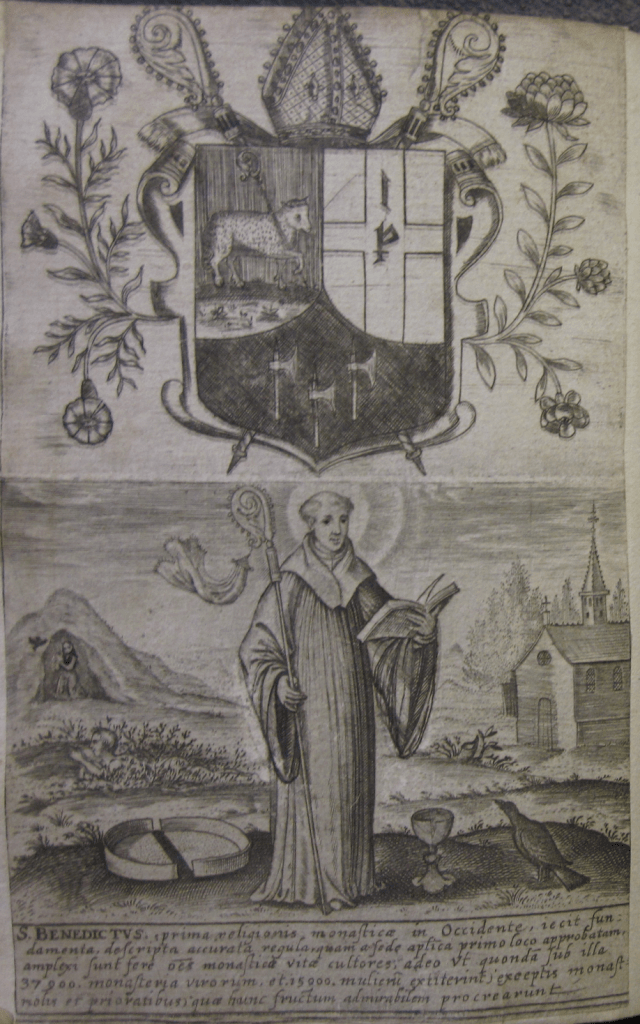By Gabrielle Harris, Emily Roth, and Kelly Plante

Gertrude More’s identity as a Benedictine nun infuses nearly every aspect of her poetry. The Benedictine way of life required More to live exclusively for God, and More’s poetry spotlights the religious ideas that structured her experiences in the English Benedictine monastery at Cambrai. One prominent Benedictine theme that consistently recurs throughout More’s poetry is the paradox of social death: that in order to live, one must first die (Lux-Sterritt 23-46).
Benedictinism derives its name from St Benedict (d. 547 CE), its founder who, forsaking his education to escape the debauchery in Rome, fled to the hills of Latium, Italy. He lived a reclusive life according to sixth-century monastic ideals, which were so notoriously difficult that many monks in Western Europe and Italy abandoned them (Butler 22). To address this, Benedict founded his own monastery and composed guidelines for monastic life that became known as the Benedictine Rule. He wanted to establish a school of God’s service that had a manner of life that, while self-denying and challenging, was not penitential (Butler 26). His Rule was targeted to monks (also known as cenobites) who were not to live as lone hermits but rather as a community. To live under the Rule was to lead a common life, working and praying collectively (Butler 27). According to the Rule, monks were never to forsake this school of God (Benedict 12). They lived in seclusion and separate from secular life in order to focus exclusively on their relationship to God (Lux-Sterritt 3). As a result, Benedictines made three vows upon their final profession: obedience, stability (a promise to remain in the same monastery), and conversion of life (faithfulness to monastic principles). Benedict intended this way of life to allow Benedictines to partake in Christ’s pains and the Passion and thus to serve as his partners in heaven (Benedict 12).
Those living in Benedictine monasteries and convents were to practice three virtues: self-discipline, prayer, and work. In fact, the Benedictine ideal can be summed up in two words: ora et labora (pray and work). In the earliest years of the order, Benedictine work involved manual labor and devotional reading (Butler 32), although the Benedictines later became known for their scholarship and preservation of classical texts. Although Benedictines of all eras copied important works such as the Bible, members of the order, including More’s contemporaries, composed hagiographies, histories, obituaries, and pious treatises that perpetuated their communities’ memories, spiritual traditions, and understandings of the Benedictine tradition.
According to Benedictinism, only one who is dead to the world can truly live for God. Laurence Lux-Sterritt explains that upon becoming an enclosed Benedictine, nuns would give up such everyday acts as dining with friends and family, and looking in the mirror (23-24). The Benedictine would become a stranger to anything not contributing toward spiritual advancement. One fragment from More’s poetry, “All things, desires, and loves are vaine,” details her spiritual death:
All things, desires, and loves are vaine,
but only that which tends
To God alone, our chiefest good,
and all things ells transcends.
My soul therefore by this sweet Love
shall day, and night aspire,
And rest in God (all things above)
my Love, and lifes desire.
(ll. 1-8)
Here, More is exchanging “all things, desires, and loves” – plural – for one singular “Love, and lifes desire”: God, who is “above” “all things.” For More, forsaking multiple “vaine” things allows her to focus “day, and night” on one “Love, and … desire”: God. Specifically, it is no longer the collective “our” by the end of these lines but, rather, it is her “soul” that now aspires, as well as rests. By focusing exclusively on one object, God, More moves from desiring to aspiring, her soul and desires, the human part of her, aligning to God and fulfilling the purpose of Benedictine life: communion with the divine.
Ultimately, More’s poetry casts Benedictinism as a way of life – not a list of rules. Grounded deeply in her understanding of Benedictinism, these works illuminate her loving relationship with, and desire for, God, thereby giving voice to the Benedictine imperative to unite the monk or nun with God.
Works Cited
Butler, Cuthbert. Benedictine Monachism: Studies in Benedictine Life and Rule. Speculum Historiale, 1962.
Lux-Sterritt, Laurence. English Benedictine Nuns in Exile in the Seventeenth Century: Living Spirituality. Manchester University Press, 2017.
St Benedict. The Rvle of the Most Blissed Father Saint Benedict Patriarke of All Mvnkes. Joos Dooms, 1632.
